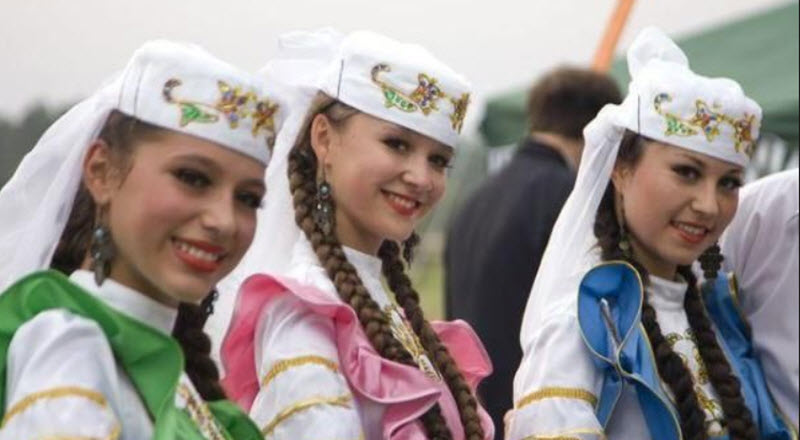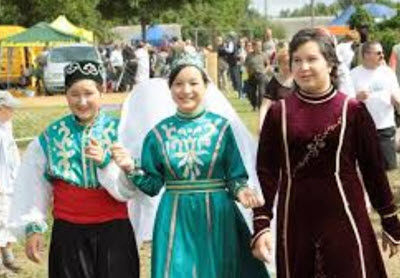
The term Lipka Tatars is used for a group of Tatars that settled in the Grand Duchy of Lithuania from the 1300s and onward. The name Lipka is derived from the old Crimean Tatar name for Lithuania.
Lipka Tatars are also known as Lithuanian Tatars, and since Lithuania eventually formed one half of the Polish-Lithuanian Commonwealth, the term Polish Tatars is also sometimes applied to the Lipka Tatars, if they reside in – or descend from – what is now the sovereign state Poland.
The migration of Tatars from the Golden Horde to the Grand Duchy of Lithuania started in the 1300s and continued until the late 1600s. The first Tatar settlers in the Grand Duchy of Lithuania were not muslim; they practised a shamanistic Asian religion and sought asylum among the non-Christian Lithuanians.
Towards the end of the 1300s, another wave of Tatars arrived to theGrand Duchy of Lithuania, and they were Muslims. This second-wave of Tartars had been invited by Vytuatas the Great, Grand Duke of Lithuania. From their very arrival to the duchy, they were known was Lipka Tatars.
This second-wave of Tatars settled in Lithuania proper, around Vilnius, Kaunas, Trakai, and Hrodna. From the Battle of Grunwald in 1410 and on onward, the Lipka Tatar light cavalry regiments were a very important part of the military.
The Lipka Tatar communities kept their muslim faith and many aspects of their culture, but over the generations they changed from speaking Tatar to adopting the language of the society around them, typically Belarusian, Lithuanian and/or Polish. A majority of the Lipka Tatar settlements were located in what is now Lithuania, Belarus, Ukraine, south-eastern Latvia, and north-eastern Poland.
Roughly 80% of the Lipka Tatars assimilated into nobility in the Polish-Lithuanian Commonwealth, while some of the lower noble Lipka Tatars instead descended into being ordinary townsfolk or peasants.
Contemporary Lipka Tatars
On this page:
The former Polish-Lithuanian Commonwealth
Today, roughly 10,000 – 15,000 Lipka Tatars live in the region that was once the Polish-Lithuanian Commonwealth.
Poland
In Poland, 1,916 residents declared Tatar ethnicity on the 2011 census. A majority of the Lipka Tatars in Poland can trace their ancestry back to noble families of the early Commonwealth era.
A monument honoring Poland’s Tatar populace stands in the port city Gdansk. It was unveiled in 2010 at a ceremony that included the Polish President Bronislaw Komorowski as well as Tatar representatives. “Tatars shed their blood in all national independence uprisings. Their blood seeped into the foundations of the reborn Polish Republic,” President Komorowski said at the unveiling.
Belarus
According to the 2009 census, there were 7,300 Lipka Tatars living in Belarus at that time.
Lithuania
According to the 2011 census, there were 2,800 Lipka Tatars living in Lithuania at that time.
USA
In the early 1900s, a number of Polish Lipka Tatars emigrated to the United States. Most of them settled in the north-eastern parts of the U.S. but there is also an enclave in Florida.
In 1928, The Islamic Center of Polish Tatars was built in Brooklyn, New York City, by the small but well-organized Lipka Tatar community there.
Examples of notable Lipka Tatars
Science
- Bruno Abdank-Abakanowicz (1852 – 1900) was a mathematician, inventor, and electrical engineer with the Riga Technical University as his alma mater. His surname Abakanowicz which has Lipka Tatar roots goes back to the szlachta of the Polish–Lithuanian Commonwealth under the Abdank coat of arms.
- Osman Achmatowicz (1899 in Bergaliszki – 1988 in Warsaw) was a Polish professor of chemistry of Lipka Tatar descent.
- Achmatowicz’s son, Osman Achmatowicz Jr, also became a chemist and was credited with the Achmatowicz reaction in 1971.
Military & Politics
- Gasan (Hasan) Konopackiy, a Russian, Belarusian and Polish military and political leader
- Aleksander Jeljaszewicz was a Major of the Polish Army, where he commanded the last Tatar/Islamic unit
- Aleksander Romanowicz was a General of Cavalry in the Russian Imperial Army and Polish Army
- Maciej Sulkiewicz was a lieutenant general of the Russian Imperial Army, Prime Minister of the Crimean Regional Government, and Chief of General Staff of Azerbaijani Armed Forces
- Aleksander Sulkiewicz was one of the co-founders of Polish Socialist Party
- Mikhail Tugan-Baranovsky was a Ukrainian statesman and economical scientist of the Russian Empire. He had Lipka Tatar ancestry on his fathers side.
Religion
- Jakub Szynkiewicz was elected as the first mufti of the newly independent Poland in 1925.
- Ibragim Kanapatsky was a Belarusian socio-political, cultural and religious figure.
- Tomasz Miśkiewicz is a Polish mufti of the Muzułmański Związek Religijny (Muslim Religious Association). In 2006, he received the Polish Silver Cross of Merit for his ecumenical work and work with minorities. In 2011, he received the Polish Golden Cross of Merit for his work with Muslim minorities and with the interfaith dialogue.
Other
- Mustafa Edige Kirimal (1911-1980) was a Crimean-born historian and politician. He is chiefly known for his research and publications on the history of Crimean Tartars. On his father’s side, he was of partial Lipka Tatar ancestry.
- Charles Bronson was a Lithuanian-American actor born in the U.S into a Roman Catholic family of Lithuanian descent. He had Lipka Tatar ancestry through his father, and his Lithuanian name was Karolis Dionyzas Bučinskis.
- Fatma Mukhtarova was a Soviet opera singer. She had Lipka Tatar ancestry thorugh her mother.
- Henryk Sienkiewicz was Polish Nobel Prize-winning novelist. On his father’s side, he was of distant Lipka Tatar ancestry.
- Magdalena Abakanowicz was a Polish sculptor and fiber artist. On her father’s side, he was of Lipka Tatar ancestry. Her father came from a Polonized Tatar family, which traced its origins to the Mongol chieftain Abaqa Khan.